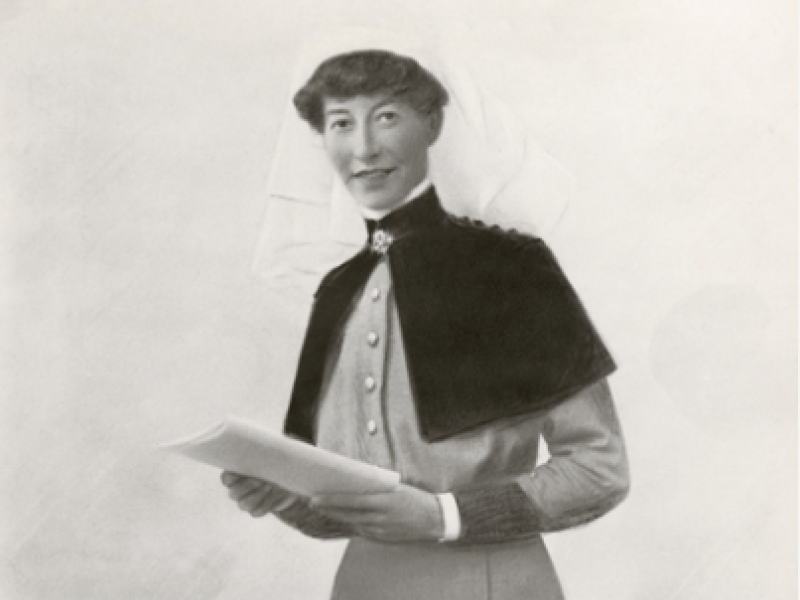Matron Jean Nellie Miles Walker
Jean Walker was born on 16 November 1878 in Hamilton, Tasmania, the youngest daughter of Alfred and Louisa Miles Walker.
After being privately educated, Jean Walker attended the Collegiate School in Hobart, and then trained at Hobart General Hospital.
She remained on as a staff nurse and then sister until 1908, when she entered private nursing. In 1913 she completed training in obstetrical nursing at the Women’s Hospital in Melbourne. She then served as matron of private hospitals at Tallangatta, Victoria, and Darlinghurst, Sydney.
In 1906, Walker joined the Australian Army Nursing Service Reserve. Within three years she was principal matron of the military district of Tasmania.
Following the beginning of the First World War, on 20 October Walker embarked on the troopship Euripides, one of 25 nurses sailing for Egypt with the Australian Imperial Force.
After several weeks in Alexandria, she joined the 2nd Australian General Hospital in Cairo. As wounded arrived from Gallipoli she took charge of the hospital while the matron was working at another location.
In September 1915, Sister Walker worked in the British hospital ship Gascon, which carried patients from Anzac Cove, Cape Helles, Mudros and Salonika to Malta, Gibraltar, England and Egypt.
Her next role was matron of the 1st Australian Stationary Hospital at Ismailia, Egypt, which treated wounded from the battle of Romani.
In October 1916, Walker was promoted to matron and transferred to the 3rd Australian Auxiliary Hospital at Dartford, England. In July 1917 she became matron of the 5th British Stationary Hospital at Dieppe in France; and in September 1917 she became matron of the 3rd Australian General Hospital at Abbeville.
In late March 1918, the German Army had launched their last major attack of the war, which would later be known as the Spring Offensive; a series of attacks planned to drive the Allies back along the length of the Western Front.
As the allies retreated towards Amiens in April, Matron Walker’s hospital was used as a casualty clearing station. Twenty-four nurses cared for around 1,800 patients as bombs fell in the area.
With the German failure to capture Amiens, the tide turned in the allies’ favour.
By October, Matron Walker was in London, attached to the 2nd Australian Auxiliary Hospital, and preparing to face a new enemy: the 1918 influenza pandemic.
Most wartime censors minimised early reports of illness and mortality, but with papers free to report the epidemic's effects in neutral Spain, the country appeared to be particularly hard hit, and so the pandemic earned the nickname “Spanish flu”.
Around 500 million people were infected worldwide, resulting in the deaths of 50 to 100 million.
Matron Jean Walker was working in the 1st Group Clearing Hospital at Sutton Veny, when she fell ill. She died not long afterwards on 31 October.
She was 39 years old.
Jean Walker was buried with full military honours on 11 November 1918, the day of the signing of the armistice that ended fighting.
During her career she had been Mentioned in Dispatches and awarded the Royal Red Cross (1st class) in 1916.
Her name is listed on the Roll of Honour at the Australian War Memorial in Canberra, among almost 62,000 Australians who died while serving in the First World War.
In 2014, 17 plaques were added to the Soldiers' Memorial Avenue in Hobart. One, and the only one dedicated to a woman, is to Jean Walker. Her name is also listed on the Hobart Town Hall honour roll, alongside over 20 other nurses from Hobart who served in the First World War. Jean is the only one who didn't return.
Matron Jean Walker’s posthumous honours include: the 1914-15 Star, the British War Medal and the Victory Medal.
Jean Miles Walker is represented on Panel 1888 of the Australian War Memorial in Canberra; on the Australian Army Nursing Service Plaque at Australian Army Museum Tasmania at Anglesea Barracks in Hobart; in a panel of the Roll of Honour Tablet at York Minster in Yorkshire; and in the Nurses' Memorial established in 1938 at Elizabeth Garrett Anderson and Obstetric Hospital in London.
She was the only Tasmanian nurse to die on active service during World War I. She was the only woman represented among the 535 plaques on Soldiers Memorial Avenue in Hobart.

 Australian War Memorial
Australian War Memorial